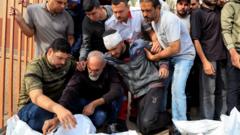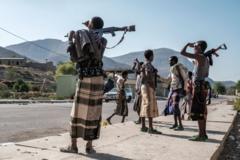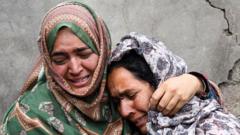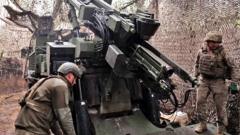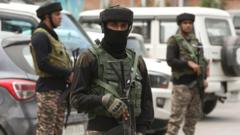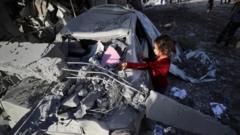As India and Pakistan exchange lethal strikes, communities find themselves deeply affected, with civilians suffering the most. After a string of military engagements across the Kashmir region, an international ceasefire has offered a brief respite, but the scars of conflict remain evident in the hearts of the affected families.
Escalating Tensions: A Four-Day Conflict Between India and Pakistan
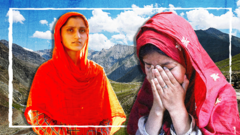
Escalating Tensions: A Four-Day Conflict Between India and Pakistan
A dramatic escalation of hostilities between India and Pakistan has left civilians like 16-year-old Nimra and 13-year-old Vihaan caught in the crossfire, resulting in tragic loss and destruction on both sides of the Line of Control.
Four days of violent clashes erupted between India and Pakistan, thrusting civilians into a perilous dance of fear and grief. In the shadow of their homes, communities found themselves mourning losses and witnessing destruction at the hands of their own governments’ military operations.
Sixteen-year-old Nimra stood helpless as Indian missiles crashed down near her home in Pakistan-administered Kashmir, injuring her with shrapnel that would later be revealed to be dangerously close to her heart. Escaping with her family to her aunt’s house, she could hardly bear the weight of the injury she had sustained. As they ran, blood soaked through her clothing, a stark symbol of the violence unraveling around them.
Meanwhile, across the Line of Control in Indian-administered Kashmir, families were caught in the retaliatory fire of Pakistani shelling. For 72-year-old MN Sudhan, that chaotic day ended with the loss of his grandson, Vihaan, whom he described with heart-wrenching clarity. “Our future was shattered… I have witnessed two wars but never anything like this,” he said, sharing the weight of a grief too heavy to carry.
This outbreak of violence marked one of the deadliest escalations between the two nations in years, with both sides claiming civilian targeting was not their intention. Though India claimed its missile strikes were retaliation for a past militant attack that resulted in multiple casualties, Pakistan countered with its own accusations and prepared a military response.
The intense shelling led to a swift escalation of hostilities, drawing local communities into the thick of their governments’ militaristic maneuvers. Reports indicated that on each side, civilian casualties mounted; with at least 16 deaths in India and civilian figures rising in Pakistan, this conflict unfolded beneath the radar of international attention—the silent suffering of innocents drowned out by political rhetoric.
Seeking to seize the moment, military officials in both nations focused on strategies and countermeasures, with Indian government sources expressing satisfaction in their operations. "We went deep… even into the Pakistani side of Punjab," an official remarked, believing the strikes to be a successful military operation. But for the families affected, these were not mere military strikes but reminders of their tragic vulnerability in the face of geopolitical maneuvering.
As news spread of the devastation, feelings of uncertainty and fear gripped both sides of the LOC. People like 47-year-old Nargis and her family found themselves fleeing their home in search of safety, but tragedy struck as she was fatally injured en route. Her daughter Sanam bravely recounted the agonizing circumstance of losing her mother, calling for leadership to prioritize civilian safety amidst such conflicts.
Amidst chaos, there was a flicker of hope on the horizon. Following multiple days of strikes, a ceasefire agreement was brokered by the United States, restoring a temporary calm within the region. The diplomatic intervention showcased the international community's ongoing concern over this long-standing conflict and its shifting dynamics.
The aftermath left stark reminders of a fragile peace, with families emerging from shelters to survey the wreckage of their lives—homes in ruins, loved ones lost, and futures that had become uncertain. Now, as the dust settles, voices like that of Umaima, who spent nights in constant fear, resonate the call for compassion and accountability on political leaders’ parts: “Those who sit in comfort and demand war, should experience what we do,” she said, yearning for a world where no child has to bear the weight of such loss again.
The delicate nature of peace between India and Pakistan once again faces a crossroads as both nations reflect on these recent events and the impacts left etched in the hearts of those caught between their ongoing conflicts.
Sixteen-year-old Nimra stood helpless as Indian missiles crashed down near her home in Pakistan-administered Kashmir, injuring her with shrapnel that would later be revealed to be dangerously close to her heart. Escaping with her family to her aunt’s house, she could hardly bear the weight of the injury she had sustained. As they ran, blood soaked through her clothing, a stark symbol of the violence unraveling around them.
Meanwhile, across the Line of Control in Indian-administered Kashmir, families were caught in the retaliatory fire of Pakistani shelling. For 72-year-old MN Sudhan, that chaotic day ended with the loss of his grandson, Vihaan, whom he described with heart-wrenching clarity. “Our future was shattered… I have witnessed two wars but never anything like this,” he said, sharing the weight of a grief too heavy to carry.
This outbreak of violence marked one of the deadliest escalations between the two nations in years, with both sides claiming civilian targeting was not their intention. Though India claimed its missile strikes were retaliation for a past militant attack that resulted in multiple casualties, Pakistan countered with its own accusations and prepared a military response.
The intense shelling led to a swift escalation of hostilities, drawing local communities into the thick of their governments’ militaristic maneuvers. Reports indicated that on each side, civilian casualties mounted; with at least 16 deaths in India and civilian figures rising in Pakistan, this conflict unfolded beneath the radar of international attention—the silent suffering of innocents drowned out by political rhetoric.
Seeking to seize the moment, military officials in both nations focused on strategies and countermeasures, with Indian government sources expressing satisfaction in their operations. "We went deep… even into the Pakistani side of Punjab," an official remarked, believing the strikes to be a successful military operation. But for the families affected, these were not mere military strikes but reminders of their tragic vulnerability in the face of geopolitical maneuvering.
As news spread of the devastation, feelings of uncertainty and fear gripped both sides of the LOC. People like 47-year-old Nargis and her family found themselves fleeing their home in search of safety, but tragedy struck as she was fatally injured en route. Her daughter Sanam bravely recounted the agonizing circumstance of losing her mother, calling for leadership to prioritize civilian safety amidst such conflicts.
Amidst chaos, there was a flicker of hope on the horizon. Following multiple days of strikes, a ceasefire agreement was brokered by the United States, restoring a temporary calm within the region. The diplomatic intervention showcased the international community's ongoing concern over this long-standing conflict and its shifting dynamics.
The aftermath left stark reminders of a fragile peace, with families emerging from shelters to survey the wreckage of their lives—homes in ruins, loved ones lost, and futures that had become uncertain. Now, as the dust settles, voices like that of Umaima, who spent nights in constant fear, resonate the call for compassion and accountability on political leaders’ parts: “Those who sit in comfort and demand war, should experience what we do,” she said, yearning for a world where no child has to bear the weight of such loss again.
The delicate nature of peace between India and Pakistan once again faces a crossroads as both nations reflect on these recent events and the impacts left etched in the hearts of those caught between their ongoing conflicts.








